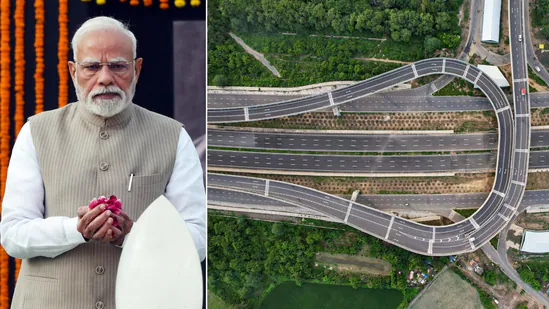
Punchline: UER-II The road that turns Delhi’s chaos into speed and its waste into wealth.
A Historic Leap in Delhi’s Infrastructure
On 17th August 2025, Delhi witnessed the inauguration of the Urban Extension Road-II (UER-II) by Prime Minister Narendra Modi—a project being hailed as Delhi’s third Ring Road. Together with the Dwarka Expressway,
UER-II represents a massive ₹11,000 crore infrastructure push that aims to transform connectivity, ease traffic congestion, and integrate Delhi with the broader NCR region.
UER-II isn’t just another road. At 75.7 km long, it has been designed as a seamless semi-circular expressway linking North, West, and South Delhi while extending into Haryana, reducing the pressure on Delhi’s overburdened Inner and Outer Ring Roads.
What Is UER-II?
Urban Extension Road-II is a modern greenfield expressway that has been constructed to serve as Delhi’s new arterial road network. Built under the aegis of National Highways Authority of India (NHAI), it is a project that combines infrastructure development with environmental consciousness.
Key Highlights:
- Length: 75.7 km
- Route: From Alipur (NH-44) to IGI Airport area (NH-48) via Rohini, Mundka, Najafgarh, and Dwarka.
- Spurs: Bawana–Sonipat and Najafgarh–Bahadurgarh
- Cost: ₹5,580 crore
- Packages: Divided into five development packages; 54.2 km in Delhi and 21.5 km in Haryana.
Why UER-II Matters: Tackling Delhi’s Traffic Woes
Delhi is infamous for its traffic snarls, with Mukarba Chowk, Dhaula Kuan, and NH-9 being some of the worst affected choke points. UER-II offers relief by diverting heavy vehicular movement away from central Delhi, ensuring faster travel between industrial hubs, residential areas, and the airport.
Benefits:
- Decongestion: Reduces load on Inner Ring Road, Outer Ring Road, and arterial city roads.
- Logistics boost: Facilitates smooth goods movement across NCR industrial corridors.
- Airport access: Easier connectivity to Indira Gandhi International Airport.
- Regional integration: Links to key expressways like Yamuna Expressway, Delhi-Dehradun Expressway, and Delhi-Mumbai Expressway.
Built from Waste: An Eco-Conscious Project
What sets UER-II apart is its sustainable construction model. Inert material and landfill waste from Delhi’s mountains of garbage were repurposed in road construction, turning an urban challenge into an engineering solution. This move not only reduced landfill burden but also showcased India’s push towards circular economy practices in infrastructure.
Political and Public Significance
The inauguration saw the presence of Delhi CM Rekha Gupta, Haryana CM Nayab Singh Saini, Union Minister Nitin Gadkari, and other top leaders. By delivering such a project before the 2026 general elections, the government is underlining its emphasis on infrastructure as a political promise fulfilled.
For citizens, however, UER-II is more than politics—it’s about saving hours of travel time, reducing vehicular stress, and breathing easier in a city choking on congestion and pollution.
UER-II and Real Estate Boom
With UER-II operational, Delhi’s Rohini, Dwarka, Najafgarh, and Bahadurgarh are expected to see a surge in real estate demand. Improved connectivity usually fuels housing growth, industrial expansion, and commercial investments. Analysts predict a sharp rise in land and property values along the corridor, replicating the trends seen around the Yamuna Expressway and Dwarka Expressway.
A Roadmap for the Future
UER-II is more than concrete and asphalt—it is a symbol of Delhi’s urban evolution. By providing faster mobility, reducing congestion, and using waste for construction, it sets a precedent for sustainable mega-infrastructure projects in India. For the common citizen, it means fewer hours stuck in traffic and more time at home, work, or leisure.
In a city where time is often lost on the road, UER-II is a reminder that smart infrastructure can reclaim it.
FOR MORE BLOGS – beyondthepunchlines.com

 Add to favorites
Add to favorites






